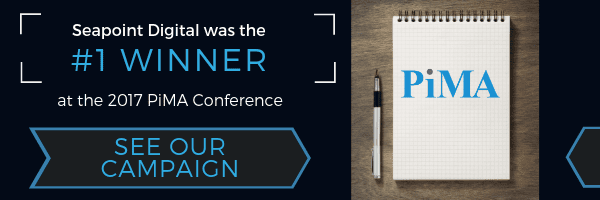With our Best of PiMA award arriving this past week, (for our work on behalf of the Texas Medical Association  Insurance Trust with a partner agency) it’s an appropriate time to reflect on and share the insights we’ve learned over the past year. As we continue to work extensively with association insurance marketing, we’ve developed and refined our Inbound Marketing strategy so we can leverage the unique challenges and opportunities that affinity marketing entails. Here are the top four lessons we’ve learned on our way to winning ‘Best of PIMA’ from the Professional Insurance Marketing Association this year.
Insurance Trust with a partner agency) it’s an appropriate time to reflect on and share the insights we’ve learned over the past year. As we continue to work extensively with association insurance marketing, we’ve developed and refined our Inbound Marketing strategy so we can leverage the unique challenges and opportunities that affinity marketing entails. Here are the top four lessons we’ve learned on our way to winning ‘Best of PIMA’ from the Professional Insurance Marketing Association this year.
Lesson #1: It’s All About The Data.
As a Hubspot Partner Agency, we’ve developed Inbound Marketing strategies across a number of industries. What makes affinity marketing unique is the value of data that is known about members and prospective clients. In a traditional Inbound Marketing strategy, an emphasis is placed on lead capture: a company offers a white paper or something else of value in order to capture prospective leads at the very beginning of their sales cycle, then hands the lead off to the sales team. With affinity marketing, much of that data is already provided to you by your association. Instead of prospecting new leads, you can focus on serving your members with the best content available. Utilizing a toolset like HubSpot and analyzing segmented data from Google Analytics will also allow you to quickly gain insight into members’ needs and their interactions with your insurance products.
While affinity marketing gives you an immediate advantage in speaking to your potential market, it also poses a number of challenges. Obviously, if your team can only sell to the members of your association, you have a finite number of potential leads. An effective way to overcome this challenge is to develop segmentations so you can reach specific members with appropriate messaging based on available data – and test the effectiveness of the messages within that data set.
 Having a limited number of potential leads can also reduce the effectiveness of traditional content marketing and SEO strategy. In a traditional model, an agency will write blogs and develop content with the hope that Google will index and rank for specific searches, thereby driving actionable traffic to your site. However, if your association is localized or maintains a very specific membership, results that are normally used to evaluate success such as “organic traffic” and “new visitors” will give an inaccurate picture of the campaign’s success.
Having a limited number of potential leads can also reduce the effectiveness of traditional content marketing and SEO strategy. In a traditional model, an agency will write blogs and develop content with the hope that Google will index and rank for specific searches, thereby driving actionable traffic to your site. However, if your association is localized or maintains a very specific membership, results that are normally used to evaluate success such as “organic traffic” and “new visitors” will give an inaccurate picture of the campaign’s success.
To market to your target audience effectively, you need accurate data as well as systems and tools that integrate correctly. Inaccuracies can lead to missed opportunities. If your connected association is using a CRM that isn’t sharing updated information and lead cycle data, you can’t nurture active leads. Your marketing efforts can also be negatively impacted by outdated data if members have changed employment, left the association, or moved out of the geographical target area of a local association.
Lesson #2: Reach Out to Members Across Multiple Channels.
How can an association insurance group compete with local agents that have a personal relationship with association members? This can be a significant challenge. Local agents may golf with your members, see them at church on Sunday, or belong to the same PTA. They are continuing to build trust with your target market in a way you may be unable to. Some members are completely unaware of the services and value you can provide. These factors can cause you to lose valuable connections with potential customers.
To overcome this challenge, it’s important to reach as many members across as many channels as possible. One way to do so is to utilize membership lists and retargeting data to deliver YouTube pre-roll videos that reinforce the commitment of your team to members and the unique value you can deliver to them. Other excellent tools that reinforce email and content marketing messaging are:
- Retargeting lists for search,
- Gmail ads utilizing your association’s URL, and
- Custom audiences on social platforms.
It’s also important to strengthen your members’ perceived connection to your association. Your team can achieve this by coordinating with your association’s social media messages, building rapport through the website and other digital spaces, and member outreach.
Lesson #3: Stay On Message.
When an association marketing team builds a marketing and content strategy, they may be tempted to deviate from their core services in the hope that it will build value in content. While there is value in providing insight to readers and building top-funnel content, your marketing efforts will be less effective if you do not primarily educate your members about products that are personally beneficial to them. Since you have a limited audience who may develop email marketing fatigue, your message should be as direct as possible. If your members have learned that your affinity insurance group offers value and expertise, they will be looking for actionable insight from your marketing efforts. If your association is profession-based, their time is likely limited and they will be looking for the most relevant messaging possible.
This is why it is so important to market to limited segmentations of your membership.  For example, the benefits of a Long Term Disability plan versus those of a Medicare Supplement product will appeal to different demographics. If your marketing team limits exposure to products that don’t fill a member’s needs, they will prevent these individuals from tuning out future (and relevant) marketing messages.
For example, the benefits of a Long Term Disability plan versus those of a Medicare Supplement product will appeal to different demographics. If your marketing team limits exposure to products that don’t fill a member’s needs, they will prevent these individuals from tuning out future (and relevant) marketing messages.
Lesson #4: Don’t Just Educate – Start Conversations.
It’s also important to include and continually test Call To Actions and other tools that allow your sales team and advisors to begin conversations. Without them, you’ve educated members – and then sent them back to their local agent to fill their insurance needs. Utilizing a platform like HubSpot will allow you to create powerful ways to reach out to those who may be educating themselves on your website, or have responded to email marketing – but not yet reached out to your sales team.
To succeed in affinity insurance marketing, there is a simple formula, but one that can be challenging to implement:
- Use consistent messages.
- Reach the right audience with solid content.
- Engage with prospects to build trust.
Does your team need help to effectively reach your members and increase leads? Let’s start a conversation. We’d like to show you how Seapoint Digital can supply the expertise to aid your affinity insurance group.
